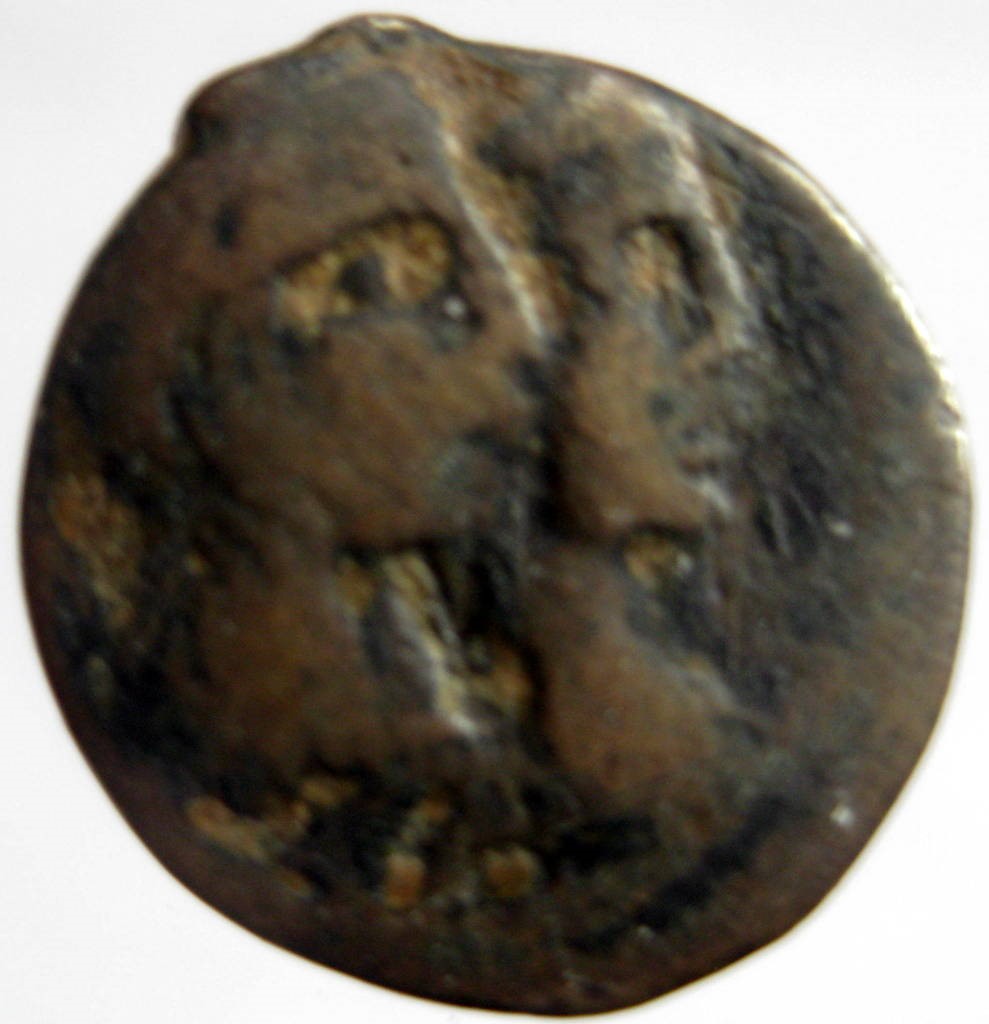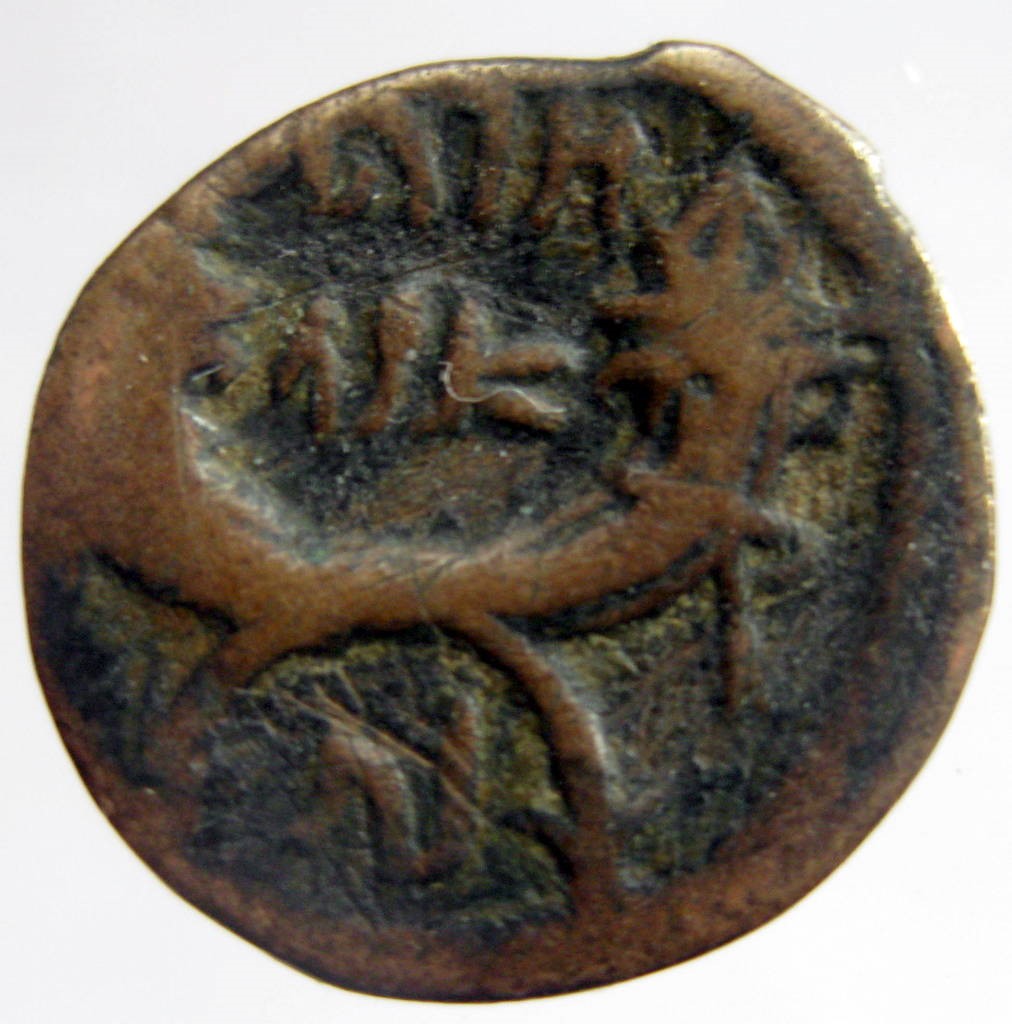Du hittar den under menyn Lagerlista – Gunnar Jönssons lagerlista
Myntmässa i Linköping 29 Februari
Linköpings myntklubb Skilling Banco anordnar myntmässa den 29 februari och vi kommer att vara där som utställare.

Myntmässa – Amagerlands Numismatiske Forening (DK) 8 Februari
Vi kommer att ställa ut på ”Møntbørs på ama’r” den 8 februari 2020

Artikel – The Nabatean Kingdom
THE EAST
Arabia Nabataea
The Nabateans were literate and developed the Arabic script but they wrote nothing of their own history. The story of their culture, customs, and kings was written by Greek and Roman writers and is suggested by their architecture, art, and brief inscriptions they left behind. As their kingdom developed, the Nabateans came into closer contact and conflict with those of the surrounding regions and their kings are mentioned increasingly by writers from those nations.
There was an early king possibly named Rekem or Raqmu for whom the city now known as Petra was named. Petra (from the Greek for “rock”) was the Greek name for the Nabatean capital of Raqmu. When this early king lived and reigned is as mysterious as the date when Petra was carved from the cliff sides. The first historically attested king is Aretas I (c. 168 B.C.) and his reign marks the beginning of the Nabatean Kingdom.
Aretas I’s date is attested by a Nabatean inscription citing 168 B.C. and he is also mentioned in the biblical Book of II Maccabees (5:8) which confirms his reign at that time. He expanded the territory of Nabatea and was known as “the Tyrant of the Arabs” by his enemies. He supported the Maccabees of Judea in their struggle against the Seleucid Greeks (c.168/167-c.160 B.C.) and allowed the forces of Judas Maccabeus to conduct raids from his territory.
The next Nabatean monarch – said to have succeeded Aretas I but most likely a later king – is known as Aretas II (also as Erotimus, r. c. 120/110-96 B.C.). Aretas II came into conflict with the Hasmonean Dynasty installed by the Maccabees owing to the Judean policies of expansion. The Hasmonean king Alexander Janneus (r. 103-76 B.C.) destroyed Gaza and took control of the terminus of the Incense Routes, infringing on Nabatean profits.
Aretas II’s successor, Obodas I (c. 96-85 B.C.) defeated Janneus in battle and reclaimed Gaza. He then defeated the Seleucid Greeks under Antiochus XII Dionysius (87-84 B.C.), killing the king and scattering his army. After this victory, he was deified by his people as attested by a memorial at his grave in the city of Avdat. He was succeeded by his brother Rabbel I (c.85 B.C.) who was killed in battle and the throne passed to another brother who took the throne name Aretas III (c. 85-60 B.C.).
Aretas III enlarged Nabatean territory to its greatest extent, controlling trade routes from Syria across Arabia toward the southern coast. In 64 B.C. the Roman general Pompey invaded and took Syria for Rome and his general Scaurus was sent to take Petra. Scaurus had no more success than Demetrius had centuries before, but the Roman army was far more powerful than the earlier Greek forces, and the Nabateans were forced to pay tribute to Rome to retain their independence.
Aretas III was succeeded by Obodas II (c. 60-59 B.C.) who died shortly after coming to power, and the throne passed to Malichus I (c. 59-30 B.C.) who was forced to submit to Herod the Great as a vassal. He was succeeded by Obodas III (c. 30-9 B.C.) who defended the Nabatean Kingdom against Rome primarily by sending his chief minister Syllaeus to “guide” the Roman army under Gallus toward Nabatean cities. Syllaeus pretended all along to be a sincere friend of the Romans and effortlessly led them astray. He was eventually executed at Rome for treachery.
Obodas III was succeeded by Aretas IV (c. 9 B.C.- A.D. 40) who is considered the greatest of the Nabatean kings. Nabatean inscriptions record his name as “Aretas, King of the Nabateans, lover of his people” and he was revered as a great monarch. His wife, Chuldu (also given as Huldu, Huldo) reigned with him and possibly on her own after his death. Aretas IV consolidated Nabatean power in the region, even in the face of Roman incursions, and was able to win recognition from Augustus Caesar as an autonomous king. Women’s rights, arts, culture, law, and the Nabatean economy all reached their height under his reign.
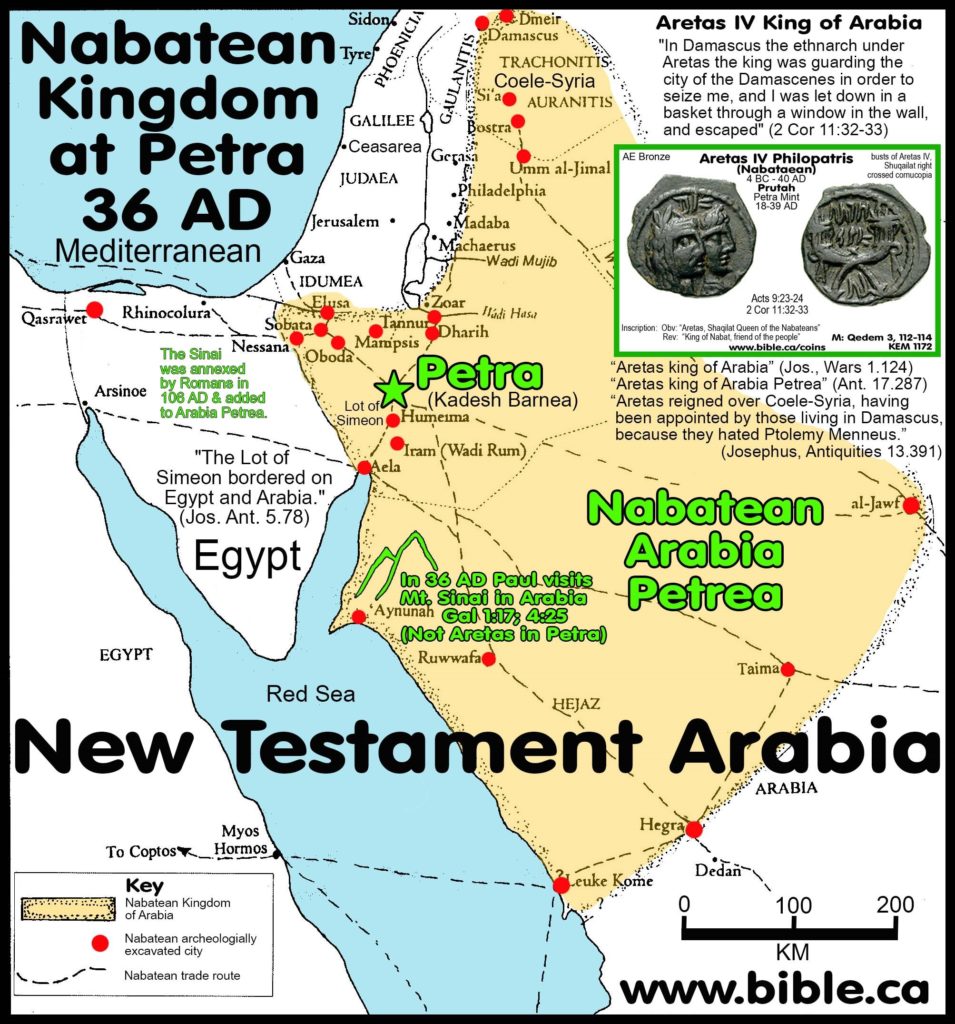
He was succeeded by his son Malichus II (c. A.D. 40-70) who lost territories to Rome and tried, unsuccessfully, to win Roman respect by sending Nabatean forces to help the Romans put down the Jewish Revolt against Roman rule in A.D. 66-70. He died, or was killed, and was succeeded by Rabbel II Soter (c. A.D. 70-106), known as the savior of his people even though he lost more territory to Rome and Nabatean prestige declined under his reign. He was briefly succeeded by his sister Gamilath, but the Nabatean Kingdom had run its course by this time as Rome grew in power, and the region as annexed as the Roman province of Arabia Petraea in A.D.106.
ARETAS I c. 168 B.C.
ARETAS II c. 120 – 96 B.C.
OBODAS I 96 – 85 B.C.
RABBEL I c. 85 B.C.
ARETAS III 85 – 60 B.C.
OBODAS II 60 – 59 B.C.
MALICHUS I 59 – 30 B.C.
OBODAS III 30 – 9 B.C.
ARETAS IV 9 B.C. – A.D. 40
MALICHUS II A.D. 40 – 70
RABBEL II A.D. 70 – 106
ARETAS IV, Philopatris 9 B.C. – A.D. 40
Aretas IV Philopatris (Ḥāritat in Nabatean) was the King of the Nabateans from 9 B.C. to A.D. 40.
Aretas came to power after the assassination of Obodas III, who was apparently poisoned. Josephus says that he was originally named Aeneas, but took ”Aretas” as his throne name. An inscription from Petra suggests that he may have been a member of the royal family, as a descendent of Malichus I.
His full title, as given in the inscriptions, was ”Aretas, King of the Nabateans, Friend of his People.” Being the most powerful neighbour of Judea, he frequently took part in the state affairs of that country, and was influential in shaping the destiny of its rulers. While on not particularly good terms with Rome and though it was only after great hesitation that Augustus recognized him as king, nevertheless he took part in the expedition of Varus against the Jews in the year 4 B.C., and placed a considerable army at the disposal of the Roman general.
Aretas had two wives. The first was Huldu to whom he was already married when he became king. Her profile was featured on Nabataean coins until A.D. 16. After a gap of a few years the face of his second wife, Shaqilath, began appearing on the coins.
His daughter Phasaelis married Herod Antipas, otherwise known as Herod the Tetrarch. When Phasaelis discovered Herod intended to divorce her in order to take his brother’s wife Herodias, mother of Salome, some time before the death of Philip A.D. 33/34, she fled to her father. Aretas IV invaded Herod’s holdings, defeated his army, partly because soldiers from Philip’s tetrarchy changed sides.
Josephus, the source for these events, says that some Jews attributed the defeat of Herod Antipas, which occurred during the winter of A.D. 36/37, to the beheading of John the Baptist.
Herod Antipas then appealed to Emperor Tiberius, who dispatched Lucius Vitellius the Elder the governor of Syria to attack Aretas. Vitellius mustered his legions and moved southward, stopping in Jerusalem for the passover of A.D. 37, when news of the emperor’s death arrived and the invasion of Nabataea was never completed.
The Christian Apostle, Paul, mentions that he had to sneak out of Damascus in a basket through a window in the wall to escape the ethnarch of King Aretas. (2 Corinthians 11:32, 33, cf Acts 9:23, 24). However, there is some dispute as to if troops belonging to Aretas actually controlled the city or if Paul was actually referring to ”the official in control of a Nabatean community in Damascus, and not the city as a whole.”
Aretas IV died in A.D. 40 and was succeeded by his son Malichus II.
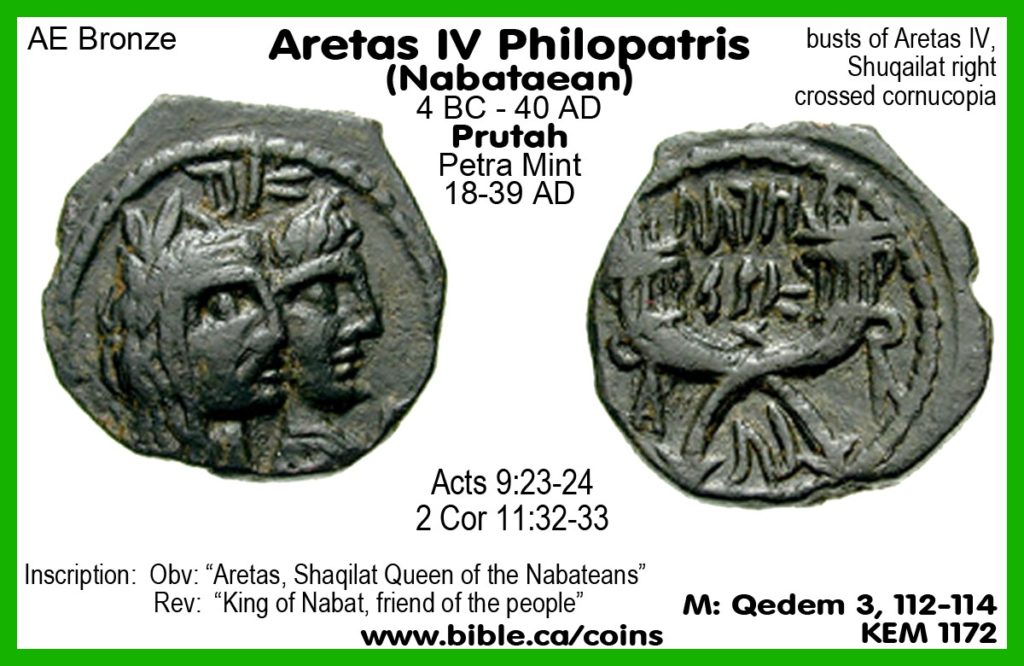
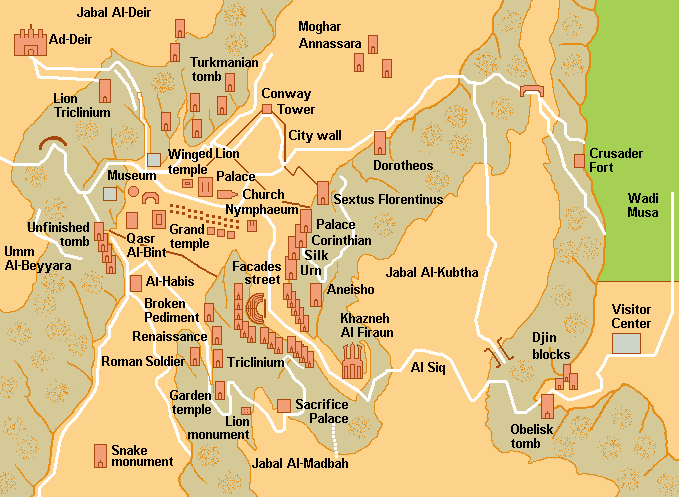
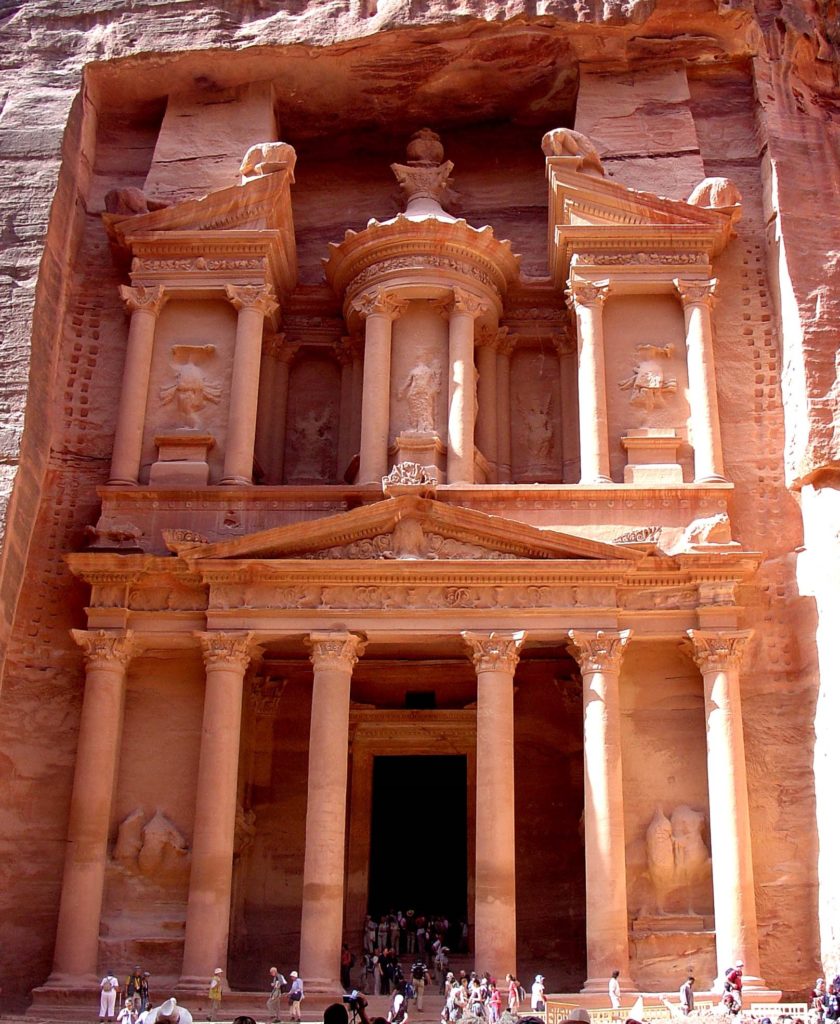
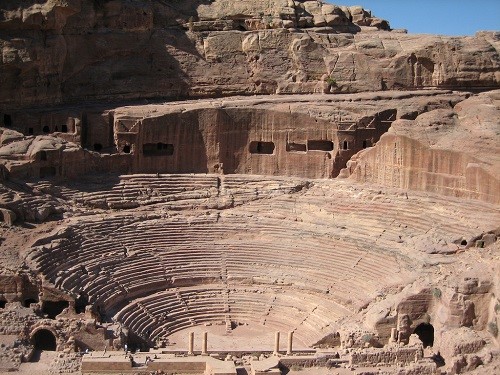
G291.5. AE 19 (Petra mint, A.D. 18 – 39, 17 mm, 4.00 g) F
Conjoined busts right of Aretas IV, laureate, and Queen Shaqilath, draped; Aramic inscription
“Aretas, Shaqilat Queen of the Nabateans”.
Two cornucopiae, crossed; between them Aramic legend “King of Nabatea, friend of the people”.
B.M.C. 28.8, 15.
References:
https://www.ancient.eu/Kingdom_of_Nabatea/
